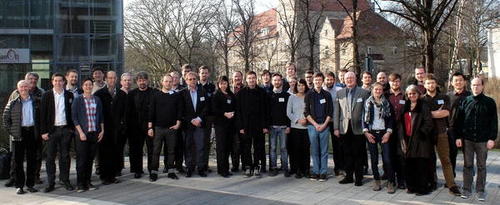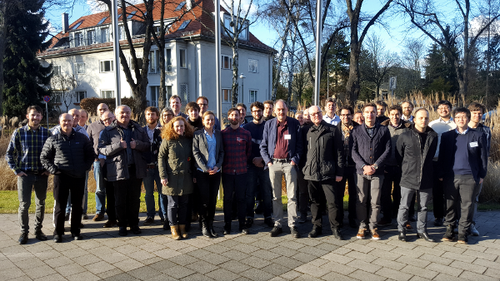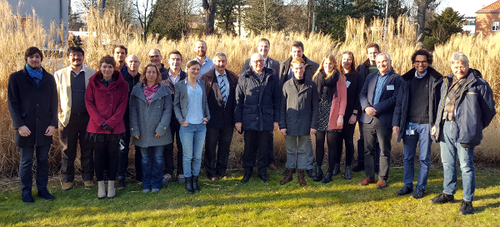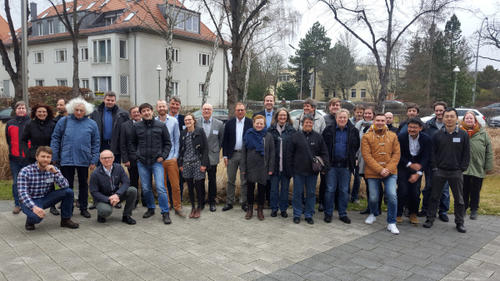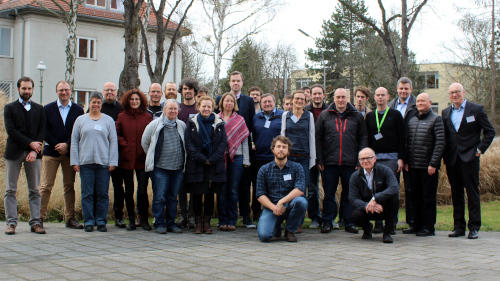PHASE Workshops
The first step towards the PHASE research project was made in November 2004. Over ten company delegates found their way to the university campus in Lankwitz, Berlin, to discuss the perspectives of a new research consortium. This consortium was going to reveal the secrets of the Physics and Application of Seismic Emissions - PHASE.
- Statistics of Fracture Strength and Fluid-Induced Microseismicity
- Dynamics of Microseismicity by Hydraulic Fracturing: An Approach to Interpretation
- Fluid-Induced Seismicity Guided by a Continental Fault System: The 2004/2005 Injection Test at the German Deep Drilling Site (KTB)
- Accurate Location of Injection-Induced Microearthquakes at the German Deep Drilling Site (KTB) at 4km Depth
- Fast Location of Seismicity: A Migration-type Approach
- Stress Sensitivity of Seismic and Electric Rock Properties of the Upper Continental Crust at the KTB
- Elastic Anisotropy of Porous and Fractured Rocks Under Stress
- Numerical Study of Transmission Signatures of Gas Hydrate Bearing Microstructures
- Reflection Coefficients of Fractured Media
Microseismic Monitoring
- Likelihood based model estimation of fluid-triggered earthquakes
- Hydraulic-Fracturing Controlled Dynamics of Microseismic Clouds
- Violation of the Kaiser effect by hydraulic-fracturing related microseismicity
- Focal mechanisms of injection-induced microseismicity at the German Deep Drilling Site
- Passive seismic monitoring at the San Andreas Fault at Parkfield, California
Numerical Rock Physics
- Effective elastic properties of fractured rocks: dynamic vs. static considerations
- Finite-difference modeling of wave propagation on microscale: A snapshot of the work in progress
- A numerical study on reflection coefficients of fractured media and their theoretical prediction
Seismic Attenuation and Poroelasticity
- Leaky mode: A mechanism of horizontal seismic attenuation in a gas-hydrate-bearing sediment
- Attenuation of P-waves due to interlayer flow in hydrate-bearing sediments
- Simulation of wave propagation in poroelastic composites
- Cross-over frequencies of seismic attenuation in porous rocks with planar fractures
- Effective fluid transport properties of deformable rocks
- Spatiotemporal pore pressure evolution due to fluid-mass point sources in dynamic poroelasticity
Stress – Modified Elasticity
- Stress Induced Elastic Anisotropy of the Etnean Basalt: Theoretical and Laboratory Examination
- Microstructural Influences on the Stress Sensitivity of Crystalline and Sedimentary Rocks
- Effective stress coefficient for elastic properties of microheterogeneous rocks
Microseismic Monitoring
- Induced seismicity in Barnett Shale: a volumetric hydraulic fracturing
- Microseismic signatures of hydraulic fracturng in tight gas sandstones with gel and water based treatment fluids
- Probability of a given magnitude earthquake induced by a fluid injection
- Monitoring of microseismicity- an application in Northern Chile
- Triggered Acoustic Emissions under time-dependent loading
- Seismicity rate and Omori law of induced microseismicity
- The physics of nonlinear diffusion and associated microseismicity in rocks with pressuredependent permeability
- Nonlinear diffusion - numerical modeling and interpretation of microseismic signatures related to hydraulic fracturing
Numerical and Theoretical Rock Physics
- Microscale modeling of effective properties of heavy oil rocks - numerical simulations vs theory
- emperature-dependent poroelastic and viscoelastic effects on microscale - Modeling of seismic reflections in heavy oil reservoirs
- On accurate finite-difference modeling of dynamic poroelasticity
- Modelling the spatiotemporal pore pressure and stress evolution for a point source in poroelastic media
- Strong dispersion and attenuation of P-waves in a partially saturated fractured reservoir
Laboratory Rock Physics
- Stress sensitivity of reservoir sandstones
- Observation of deformation caused by pressure changes and its influence on seismic velocities and elastic moduli in a Chauvigny Limestone
- Seismo-acoustic signatures of temperature dependent geothermal rocks at in-situ reservoir conditions
Seismic Imaging
- Seismic imaging - a summary
Microseismic Monitoring: Imaging and Event Analysis
- Earthquake Location Based onWaveformSimilarity and Application to aMicroseismic Dataset
- Active Seismic Imaging UsingMicroseismic Events: Results fromthe San-Andreas-Fault System at SAFOD
- Microseismicity Location, Seismic Reflectivity Imaging and their Correlation at KTB
Microseismic Monitoring: Physical Fundamentals and Interpretation
- Triggering Fronts and Magnitude Distributions of Seismicity Induced by Non-Linear Fluid- Rock Interactions
- Analysis of InducedMicroseismicity of a Geothermal Reservoir Stimulation in Basel, Switzerland
- Omori Law for Fluid Induced Microseismicity and its Dependency on Parameters of Reservoir and Source
- Fluid-Induced Microseismicity in Pre-Stressed Rock Masses
- In Situ AE Records in Cyclically Loaded Rock Salt- The Kaiser Effect and Spatio-Temporal Characteristics
- Analysis of Microseismicity at the Precordilleran Fault System at 21oS in Northern Chile
Microseismic Monitoring: Laboratory Studies
- Acoustic Emission by Fluid Injection Into Dry Rocks
Numerical Modelling and Rock Physics
- Coupled Changes in Reservoir Pore Fluid Pressure and Stress - Poroelastic Contribution to the Reservoir Stress Path
- Comparing the Numerical Abaqus Solution with an Analytical Solution forModelling Poroelasticity
- Estimating Effective Elastic Properties of Heterogeneous Porous Media Using Quasistatic Finite-Element Modelling
- Stress-Dependent Anisotropy of Shale: an Example
Microseismic Monitoring: Imaging and Event Analysis
- Microseismic Event Relocation Using Arrival Times and Cross-Correlation Coefficients: A Synthetic Study
- An Approach to Analyse Microseismic Event Similarity
- Time Reverse Characterization of Sources in Heterogeneous Media
- Microseismic Imaging at KTB
- Active Seismic Imaging Using Microseismic Events: Results from the San-Andreas-Fault System at SAFOD
Microseismic Monitoring: Physical Fundamentals and Interpretation
- Magnitude Probability of Events Induced During Injections and Seismogenic Index of Injection Sites
- Inter Event Times of Fluid Induced Microseismicity
- Scaling Laws for Post Injection Seismicity
- Reservoir Diffusivity Estimation by Analysis of the Temporal Evolution of theMicroearthquake Density
- Fluid Induced Seismicity by Time-dependent Injection Pressures: Theoretical Formulations and Case Study
- Quantitative analysis of diffusivity estimates obtained from microseismicity with underlying pressure dependent transport properties
- Magnitude Estimation for Microseismicity Induced During the KTB 2004/05 Injection Experiment
- Indications for AE Activity on a Macrocrack Controlled by Thermal Stress Diffusion and Static Stress Transfer
- Tensor Character of Pore Pressure / Stress Coupling in Reservoir Depletion and Injection
Microseismic Laboratory Studies and Rock Physics
- Acoustic Emission induced by Pore Pressure Pulses in Sandstone Samples
- Stress Induced Elastic Anisotropy of Shales
Microseismic Monitoring: Imaging and Event Analysis
- Application of aWaveformSimilarity- Based Location Algorithmto the Basel 1 Microseismic Data
- Microseismic Imaging of a Hydraulic Reservoir Stimulation: Basel
- Waveform Similarity Analysis at Cotton Valley, Texas
- Reflection Coefficients at a Thin Fluid Layer as a Model of a Hydraulic Fracture
Microseismic Monitoring: Physical Fundamentals and Interpretation
- Geometric Control of Earthquakes Induced by Fluid-rock Interactions
- Seismotectonic State of Reservoirs Inferred From Induced Microseismicity
- Probability of Earthquake Occurrence andMagnitude Estimation in the Post Injection Phase of Geothermal Projects
- Poroelastic Coupling and Triggering of Microseismicity
- Geomechanical Interpretation of Pore Pressures TriggeringMicroseismicity
- Modelling Studies to Investigate Critical Pore Pressures of Fluid-Induced Seismicity at the Basel Geothermal Reservoir
- Influence of Nonlinear Fluid-rock Interaction on Hydraulic Fracturing Induced Seismicity from Barnett Shale
- Diffusivity and Tectonic Potential Estimation fromMicroseismic Event Density
- Feasibility of Microseimic Monitoring at Lower Saxony’s Rotliegend Reservoirs
Laboratory Studies and Rock Physics
- Attenuation in Obernkirchner Sandstone, Preliminary Results
Microseismic Monitoring: Imaging and Event Analysis
- Distribution of the Vp/Vs Ratio within the Basel 1 Geothermal Reservoir from Microseismic Data
- Waveform based clusterization at Cotton Valley, Texas
- Microseismic-reflection imaging of large-scale tectonic structures: A case study fromthe Central Andes
Microseismic Monitoring: Physical Fundamentals and Interpretation
- Bounds of Magnitude Probability for Seismicity Induced by Stimulations of Reservoirs
- Reflections at a Thin Fluid Layer Representing a Hydraulic Fracture
Laboratory Studies and Rock Physics
- Acoustic Emission in Sandstone Samples: Pore Pressure Pulses and Kaiser effect
Microseismic Monitoring: Imaging and Event Analysis
- Distribution of the Vp/Vs Ratio within the Basel 1 Geothermal Reservoir from Microseismic Data
- Multi-source Multi-receiver Microseismic Reflection Imaging: Case Study Basel
- Multiplet Based Extraction of Geological Structures
- Microseismic-reflection Imaging of Large-scale Tectonic Structures: A Case Study from the Central Andes
- Reflections at a Thin Fluid Layer Representing a Hydraulic Fracture
- The Influence of Anisotropy on the Location of Microseismic Events
Microseismic Monitoring: Physical Fundamentals and Interpretation
- Bounds of Magnitude Probability for Seismicity Induced by Stimulations of Reservoirs
- Characterisation of the Seismotectonic State of Reservoir Locations Using the Magnitude Distribution of EarthquakesI
- Inter Event Times of Fluid Induced Earthquakes Suggest their Poisson Nature
- Geo-mechanical Modeling of Fracture Strength Distribution in Elastically Heterogeneous Rocks
- Acoustic Emission in Sandstone Samples: Pore Pressure Pulses and Kaiser effectMicroseismic Back Front Signatures for Nonlinear Fluid-Rock Interaction
Case Studies & Feasibility Studies
- A Hydraulic Fracturing Case Study (I): Estimates of fracture geometry and fluid transport properties from hydraulic fracturing induced seismicity
- A Hydraulic Fracturing Case Study (II): Location of Induced Microseismic Events Using a Single Vertical Borehole Array
- A Hydraulic Fracturing Case Study (III): Interpretation of New Locations and Comparative Analysis of Fracture Geometry and Fluid Transport Properties
- SBRC of a Geothermal Reservoir in Cooper Basin, Australia
- Seismic Monitoring in the Pilot Project CLEAN
Microseismic Monitoring: Imaging and Analysis of Microseismic Wavefields
- Joint Arrival Time Optimization for Microseimic Events Recorded by Seismic Borehole Arrays
- Precise Seismic Event Relocation Using Waveform Cross-correlation and Source Specific Station Terms
- Fault Plane Solutions for Multiplet Events
- Rupture Propagation Imaging at Microseismic Scale
- Simultaneous Inversion of Anisotropic Velocity Model and Microseismic Event Location: Synthetic and Real Data Examples
- Microseismic Reflection Imaging: Methodology and Applications
- Modeling Reflection Coefficients at a Thin Fluid Layer Representing a Hydraulic Fracture
- Overview of a Data Set of a three Stage Hydraulic Fracturing Treatment in a Shale Gas Reservoir
Microseismic Monitoring: Physical Fundamentals and Interpretation
- Relations Between Elastic Rock Heterogeneity, Stress Fluctuations and the Gutenberg Richter b-value of Earthquakes
- Triggered versus Induced Events and Bounds of the Magnitude Probability
- Numerical Simulations of Pore Pressure Diffusion in Hydraulically Heterogeneous Media
- Influence of Hydraulic Heterogeneity of Rocks on Pore Pressure Changes Induced by Reservoir Stimulations
- Permeability as a Function of Stiff and Compliant Components of Pores and Cracks and its Stress Dependence
- Influence of Nonlinear Fluid-rock Interaction on the Back Front of Seismicity
- Permeability Tensor Characterization from the Back Front of Seismicity
Microseismic Monitoring: Imaging and Analysis of Microseismic Wavefields
- Ray-tracing for Microseismic Monitoring in Strongly Anisotropic Media
- Seismic Anisotropy of Shales: Inversion of Microseismic Data
- Modeling Wave Propagation in Anisotropic Media
- Common-receiver Gathers as a Tool for Analysis of Microseismic Waveforms and Quality of Time Picks
- A Multiple-based Processing Tool and Possible Applications
- Observation and Signatures of Injection-induced Repeating Earthquake Sequences
- Rupture Propagation Imaging at Microseismic Scale Using Back Projection Imaging
- Estimation of Local Vp/Vs-ratios in a Subduction Zone
Microseismic Monitoring: Physical Fundamentals and Interpretation
- Elastic Rock Heterogeneity Controls Brittle Rock Failure During Hydraulic Reservoir Stimulation
- Scaling of Magnitude Frequencies by Fluid Injections in Reservoirs
- Analysis and Interpretation of Hydraulic Fracturing Induced Seismicity From the Horn River Basin
Laboratory Studies and Rock Physics
- Development of Fractures in a Water-saturated Triaxially Stressed Sandstone Sample With Respect to Pore-pressure Changes
- A Model of Permeability Dependence on Stiff and Compliant Porosities of Rocks and Some Experimental Examples
Microseismic Monitoring: Imaging and Analysis of Microseismic Wavefields
- Arrival Time Picking on Common Receiver Gather
- Multiplet Identification at two Case Studies: Horn River Basin Hydraulic Fracturing of Shale and Basel EGS
- Using Multipath Shear Wave Arrivals for Velocity Model Inversion and Microseismic Location in Strongly Anisotropic Shale
- Rock Physics Constrained Estimation of Shale Anisotropy for Microseismic Processing - From VTI to Orthorhombic
- Source Characterization of Microseismic Events Using Empirical Green’s Functions
- Reflection Coefficient Estimates from Microseismic Waveform Data
- Overlapping Voronoi Volume Clusterization as a Tool for Volumetric Parameter Estimation from Earthquake Data
Microseismic Monitoring: Physical Fundamentals and Interpretation
- Quantitative Analysis of Rock Stress Heterogeneity: Implications for the Seismogenesis of Fluid Injection-Induced Seismicity
- Poroelastic Stress Modeling and Simulation of Production Induced Seismicity: Case Study Unterhaching Geothermal Reservoir
- 3D-Modelling of Non-linear Pore-fluid Pressure Perturbation Based on Induced Seismicity from Barnett Shale
- Diffusivity Mapping from Injection Induced Microseismic Events
Laboratory Studies and Rock Physics
- Permeability Contributions of Stiff and Compliant Porosity: Theory and Some Core Measurements
Microseismic Monitoring: Imaging and Analysis of Microseismic Wavefields
- Eikonal Equation Approach for Seismic Speed Tomography from Micro Earthquakes
- Rock Physics Constrained Estimation of Shale Anisotropy Using Downhole Microseismic Data
- Sonic Log Based Velocity Optimization with Perforation Shots in Unconventional Oil and Gas Field
- Anisotropic Velocity Model Inversion
- 3D Anisotropic Full Waveform Modeling with an Enhanced OASES Workflow for Complex Source-receiver Geometries
- Anisotropic Source Mechanism Construction and Waveform Modeling
- Observations on Rupture Directivity of Fluid Induced Events at the Basel EGS
- Rupture Complexities of Fluid Induced Microseismic Events
- Fracture Zone Characterization by Quantitative Analysis of Reflected Phases from Microseismic Waveform Data
- Comparing Stacks of Different Seismic Attributes for Micro-Seismic Event Detection
Microseismic Monitoring: Physical Fundamentals and Interpretation
- A Statistical Model for Seismic Hazard Assessment of Hydraulic-Fracturing-Induced Seismicity
- Geometrical Scaling of the Magnitude Frequency Distributions of Injection Induced Earthquakes: Implications for the Assessment and Mitigation of Seismic Hazard
- Induced Seismicity Generated by Numerical Pore-fluid Pressure Modeling and Poroelastic Stress Modeling and Application to Unterhaching Geothermal Reservoir
- Scaling of the Back Front of Seismicity Induced by Non-linear Pore-fluid Pressure Diffusion
- Segmented Dyke Growth and Associated Earthquakes at Bardarbunga Volcanic System (Iceland) are Driven by Non-Linear Magma Pressure Diffusion
Laboratory Studies and Rock Physics
- Impact of Arbitrarily-oriented Stress on Elastic Anisotropy of Rocks
Microseismic Monitoring: Imaging and Analysis of Microseismic Wavefields
- Evaluation of Seismic Attributes for Micro-Seismic Event Detection
- Automatic Determination of Moveout Parameters for Microseismic Event Detection
- Semi-auto Picking Using Array Seismogram Volume
- Microseismic Data Processing in Shale Gas Field: Orthorhombic Velocity Parameter Factorizing, Hypocenter Locating and Moment Tensor Inversion
- Anisotropic Velocity Model Inversion
- Source Mechanism Reconstruction in Anisotropic Media
- Numerical Test Study of the Eikonal Equation Tomography Approach
Microseismic Monitoring: Physical Fundamentals and Interpretation
- Magnitude Clustering & Nearest Neighbor Analyses of Hydraulic-Fracturing Induced Seismicity
- Scaling of Injection-Induced Earthquake Magnitude Statistic and Implications for Seismic Hazard Assessment
- Forecast of Magnitude Frequencies and Estimation of the Maximum Magnitude of Earthquakes Induced by Gas Production in Groningen
- Linear Diffusion in a Hydraulically Heterogeneous Medium - An Approach to Explain Signatures of Fluid-induced Seismicity
Laboratory Studies and Rock Physics
- Elastic Properties of Triclinic Porous and Fractured Rocks Under Triaxial Effective Stresses
Microseismic Monitoring: Imaging and Analysis of Microseismic Wavefields
- Ray Tracing with Adaptive Step Size Control in Inhomogeneous Anisotropic Media
- Traveltime Picking Uncertainties
- A Comparison of Microseismic Source Location Methods: Probabilistic vs. Migration-Based Approaches
- Automatic Microseismic Event Detection by Moveout Parameter Estimation from Surface Receiver Array Data
- Visualizing Effects of Anisotropy on Seismic Moments and Their Potency-Tensor Isotropic Equivalent
- Relocation and Moment Tensor Inversion of Seismic Events in the Groningen Field
- Search for Similar Events in Continuous Seismic Data: Method and Application to the Seismic Sequence of the 2014 Mw 8.1 Iquique Earthquake, Chile
Microseismic Monitoring: Physical Fundamentals and Interpretation
- Numerical Modeling of Injection-Induced Seismicity Obeying the Lower Magnitude Bound with Spatially Correlated Criticality Fields
- Reservoir-Induced Seismicity: A Possible Explanation for Seismicity in Central Oklahoma, U.S.?
- Statistical Analysis and ETAS Modeling of Seismicity Induced by Production of Geothermal Energy from Hydrothermal Systems
- Seismogenic Index and Poroelastic Coupling by Fluid Injections and Productions
- Seismogenic Index, Maximum Magnitude and Stress Drop of Earthquakes Induced by Fluid Production or Injection
Microseismic Monitoring: Imaging and Analysis of Microseismic Wavefields
- Automatic Microseismic Event Detection from Surface Data and its Relation to Downhole Data
- Adaptive Step Size Control for Kinematic and Dynamic Ray Tracing
- Distinguishing Various Types of Double-Couple Faulting in Anisotropic Rocks
Microseismic Monitoring: Physical Fundamentals and Interpretation
- Rupture Propagation Imaging Across Scales
- Stress Drops Derived from Spectral Ratios: Application to a Dataset from Northern Chile
- Stress Drop and Seismogenic Index of Fluid-Induced Earthquakes
- Stress Conditions for Dip-Slip Events During Hydraulic Fracturing
- Seismicity in Oklahoma has Features of Reservoir-Induced Seismicity
Laboratory Studies and Rock Physics
- Stress-Dependent Elasticity: Laboratory Measurements under Uniaxial Loading, and Theoretical Modelling of Vertical Transversely Isotropic and Orthorhombic Shales
Microseismic Monitoring: Imaging and Analysis of Microseismic Wavefields
- First Localization Results for Pre-Detected Microseismic Events from Surface Data
- Event Localization Using Surface and Borehole Data
- Kinematic and Dynamic Ray Tracing with Adaptive Step Size Control in Inhomogeneous Anisotropic Media
- Statistics of the Seismic Sequence and Rupture Directivity of the M5.5 Earthquake in Orkney, South Africa
Physics of Induced Seismicity, Geomechanics and Rock Physics
- Rotations of the Local Stress Field at the Tip of Hydraulic Fractures: A Driving Mechanism for Half-Moon Events?
- Towards the Understanding of Large-Scale Migration Patterns of Wastewater Disposal Induced Earthquakes in the Central U.S.
- Fault Cohesion, Earthquake Stress Drop and Evolution of Seismogenic Index at Reservoirs with Long-Term Fluid Operations
- Modeling of the Pohang Earthquake Probability Using the Seismogenic Index
- Towards Integrated Modeling of Deformations, Time-Lapse Seismic Effects and Failure Stresses Caused by Massive Underground Fluid Operations
- Sedimentary Rock Samples Under Uniaxial Loading Conditions: Influence of Lithology and Sample Orientation
- Stress-Dependent Elasticity of Saturated Rocks: Porosity Deformation Approach and Fluid Flow Models Combined
Microseismic Monitoring: Imaging and Analysis of Microseismic Wavefields
- Microseismic Event Detection in the Spectral Domain - Application to Borehole Data, Surface Data and DAS Data
- Detection of Microseismic Events Induced at the Utah FORGE Site Using Distributed Acoustic Sensors (DAS)
- Paraxial Traveltimes from Ray Tracing with Adaptive Step Size Control
Physics of Induced Seismicity, Geomechanics and Rock Physics
- A Poroelastic Correction for Mmax
- A Geomechanical Model for Half-Moon Events
- Production-Induced Earthquakes in the Groningen Gas Field: New Results of Poroelastic Modelling
- A Stress Drop Variation Study in the Rupture Region of the 2014 MW8.1 Iquique Earthquake, Northern Chile
Microseismic Monitoring: Imaging and Analysis of Microseismic Wavefields
-
Automatic Picking using Deep Neural Networks for Event Detection and Localization
-
Event Detection at the Utah FORGE using DAS Data
-
Template Approach for Detecting Local Seismicity
Physics of Induced Seismicity, Geomechanics and Rock Physics
-
Seismogenic Index for Induced Hazard: New Developments
-
Maximum Magnitude Estimates in Groningen
-
Water-Disposal Induced Seismicity in Oklahoma and Kansas
-
Geomechanical Modeling of Discrete Fracture Networks
Microseismic Monitoring: Imaging and Analysis of Microseismic Wavefield
-Detection of micro-earthquakes by processing DAS seismograms
-Micro-earthquakes detection using machine learning on DAS waveforms
-Detection of tectonic seismicity using machine learning
-Detection of tectonic seismicity using template matching
Physics of Induced Seismicity, Geomechanics and Rock Physics
-DAS and micro-seismic signatures of hydraulic fractures in shale
-Fractal characteristics of fractures in crystalline rocks
-Pressure diffusion controls Mmax of induced earthquakes
-About the probability of a strong earthquake in the Groningen gas field
-Stress drop of earthquakes induced by subduction processes
Der nächste PHASE Workshop ist für den 22. und 23. Februar 2024 geplant.
